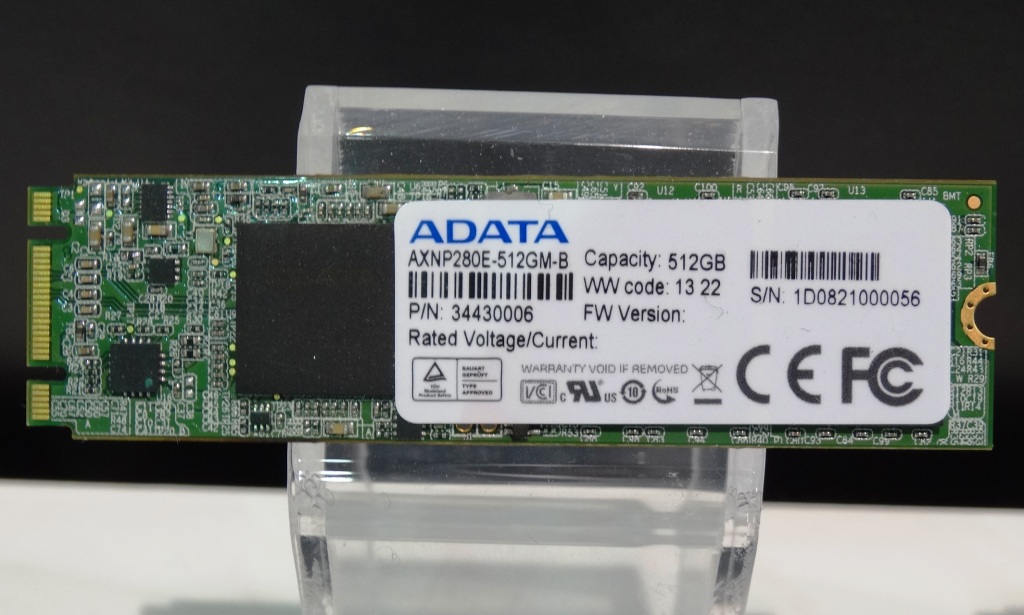Imagine 1.8GB/s read and write performance with up to 200, 000 IOPS being possible in a NGFF/M.2 form factor. This not only verifies that LSI SandForces new controller, Codename Griffin, is about to make an amazing transformation in the SSD industry, but also, these blistering speeds will be seen soon enough in ultrabooks.
The fact is that ADATA has made so many introductions this year that our previous, and this picture below, are being overlooked by all:
This blade style SSD is a single chip solution that is available in capacities of 128, 256 and 512GB and support a PCIE 2 x4 lane interface through it’s NGFF form factor. Is that even possible? With SMART, DEVSLP, NCQ and TRIM support, this SSD is going to revolutionize what we are seeing in todays SSD arena.
We will be the first to say that both LSI and ADATA are now remaining completely silent with respect to any details of both this and ADATAS new Griffin controlled enterprise SSD, which should say something. The ONLY thing that we do know is that release will be in late third or early fourth quarter this year.
The entire outlook of an ultrabook design has just changed. With the new SATA DEVSLP specification allowing your ultra to go into a very low power sleep while continuously updating, just as your smartphone today, and at the same time having speeds that are faster than we are seeing today, new ultras will have an entirely new face within the next year or so!
 The SSD Review The Worlds Dedicated SSD Education and Review Resource |
The SSD Review The Worlds Dedicated SSD Education and Review Resource | 


Why did you think it is griffin based…. or even lsi based?
it is codenamed Griffin. The fact that it is LSI Sandforce based was learned and confirmed with industry professionals as we reported.
This is LSI Confidential.
Great numbers, maxing out the PCIe 2.0 4x completely and in a beautiful form factor! Truly a massive throughput/volume jump!
The specs it cites sound vanilla SATA / AHCI yet the speed is faster than SATAIII. Is this still alike a SATA device with a queue-depth of 32 (QD32), an AHCI device, or NVM-E alike with a bigger queue depth? Up to QD-256queues-256messages-per-queue in NVM-E? Is it a standard device (NVMe, SCSIe, AHCI) or something custom?
Either SATA-Express (looks like ACHI) or NVM-Express (streamlined newer), I hope. Fast either way, nice.
Hypothetically could this work with the New ASUS Maximus Extreme VI?
Yes.
https://rog.asus.com/238712013/maximus-vi/this-is-why-ngff-is-the-best-choice-for-maximus-vi-motherboards/
Every day I visit this site, SSD speeds have gone up, capacity has gone up and prices continue to come down. Great reporting, Les!
Where can I pick one of these up? Well, actually I really mean two. The new Samsung PCIe SSD that’s in the new MacBook Air is a tiny little stick of yummy NAND and beats to a pulp my setup of two RAID’ed 6Gbps SATA III drives in my Ivy Bridge Mac mini. That’s incredible.
And now we’re talking about 1GB/s and I want to say that I even noticed 1.8GB/s in another review? What’s available now and what do you recommend for a PCI-e SSD setup? I’m standing by for a Haswell refresh for the Mac mini as well as Retina MBP, but I’m entertaining other options. 😀
ANY New NGFF PCIe solution will be out of consumer hands for some time I would guess, limited only to OEM ultra and notebook sales much the way mSATA was. We have a number of NGFF drives on hand and, as well, we are awaiting arrival of all parts for our new Haswell build. Retina MBP?
Retina MacBook Pro. It should get a refresh shortly and will likely include, at a minimum, the PCIe-based SSD that’s found in the MacBook Air. I’m hoping for something even better since Apple didn’t refresh the Retina MBPs at their last developer’s conference a month ago.
Thanks Les.
Lol. So; after 4 years, yet again, nobody shows where you plug it in. No BIOS changes required? Nobody mention is if you can Clone across from an Existing HDD or SSD installed. Then take that out and change the ADATA /Drive letter to C: